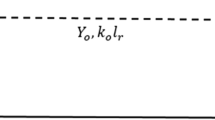Abstract
This paper proposes an optimal design scheme to improve the muffler’s capacity of noise reduction of the exhaust system by combining the Taguchi method and a fractional factorial design. As a measuring tool for the performance of a muffler, the performance prediction software which is developed by Oh, Lee and Lee (1996) is used, In the first stage of a design, the length and radius of each component of the current muffler system are selected as control factors. Then, theL 18 table of orthogonal arrays is adopted to extract the effective main factors. In the second stage, the fractional factorial design is adopted to take interactions into consideration, which theL 18 table of orthogonal arrays can not consider. For an optimal design, theL 27 table of orthogonal arrays with main and interaction effects is proposed and the noise factors such as temperature, background noise and humidity are analyzed for more efficient design simultaneously.
Similar content being viewed by others
References
Bendell, A., Disney, J., and Pridmore., A. 1989,Taguchi Methods: Applications in World Industry, Springer-Verlag, New York.
Box, G.E.P., Hunter, W.G., and Hunter., J.S., 1978,Statistics for Experiments, Wiley & Sons, New York.
Cochran, W. G. and Cox., G. M., 1957,Experimental Designs, Wiley & Sons, New York.
Craggs, A., 1976, “A Finite Element Approach for Damped Acoustic Systems: An Application to Evaluate the Performance of Reactive Mufflers”, Journal of Sound and Vibration, Vol. 48, pp. 377–392.
Hwang, W.J., Park, G.J. and Lee, W.I., 1994, “Structural Optimization Post Processing Using Taguchi Method”,JSME, Series A, Vol. 37, No. 2. pp. 166–172.
Kim, J. K., 1999, “Optimum Design of a Heat-Exchanger-Fan Casing of Clothe Using the Taguchi Method”,KSME International Journal, Vol. 13 No. 12, pp. 962–972.
Lee, K.H., Eom, I.S., Park, G.J. and Lee, W.I., 1995, “Robust Design for Unconstrained Optimization Using Taguchi Method”,AIAA Journal, Vol. 34, No. 5, pp. 1059–1063.
Mason, R.L., Gunst, R.F., and Hess, J.L., 1989,Statistical Design and Analysis of Experiments, Wiley & Sons, New York.
Mishima, Nozomu, Ishii, Kosuke, and Mori, Kazuo, 1998, “Robustness Estimation for Machine Tool Designs Using Taguchi Method”,SOURCE Journal of the Japan Society for Precision Engineering, Vol. 64, pp. 1502–1506.
Munjal, N.L., 1987,Acoustics of Ducts and Mufflers, Wiley & Sons, New York.
Oh, J.E., Han, K.H., and Lee., J.C., 1995, “Analysis and Advance for Performance of the Muffler of a Passenger Car”,Proc. of Spring Conference, pp. 726–732 (in Korea).
Oh, J.E., Han, K.H., and Son, D.Y., 1996, “The Design Technique for Low-Noise Intake System of Vehicle”,Proc. of Autumn Conference, Korean Society of Automotive Engineering, pp. 317–322 (in Korea).
Oh, J.E., Lee, K.T., and Lee, J.C., 1996, “Development of the Software for Analysis and Improvement of a Passenger Car’s Muffler”,Journal of Automotive Engineering, Korean Association of Automotive Engineering, Vol. 4, No. 6, pp. 133–143 (in Korea).
Park, S.K., 1994, “Application of Quality Engineering for Energy Efficiency of Compressor”,The 12th Annual Taguchi Symposium, Rochester, New York, pp. 199–211.
Sahasrabudhe, A.D., Anantha R.S. and Munjal, M.L., 1991, “Matrix Condensation and Transfer matrix Techniques in The 3-D Analysis of Expansion Chamber Muffler”,Japan of Sound and Vibration, Vol. 143, No. 7, pp. 37l-394.
Taguchi, G., 1991a.,Quality Engineering of Development and Design, Korea Standard Association, Translated to Korean.
Taguchi, G., 1991b.Experimental Designs for Quality Engineering, Korea Standard Association, Translated to Korean.
Taguchi, G., 1991c,Case Studies of Quality Engineering-America and Europe, Korea Standard Association, Translated to Korean.
Wang, H.T., Liu, Z.J., Chen, S.X., Yang, J.P., 1999, “Application of Taguchi Method to Robust Design of BLDC Motor Performance”,SOURCE IEEE Transactions on Magnetics, Vol. 35 No. 5, pp. 3700–3702.
Young, Cheng. J. and Crocker, M. J., 1975, “Prediction of Transmission Loss in Mufflers by the Finite Element Method”,The Acoustical Society of America, Vol. 57, No. 1, pp. 144–148.
Author information
Authors and Affiliations
Rights and permissions
About this article
Cite this article
Oh, JE., Cha, KJ. Noise reduction of muffler by optimal design. KSME International Journal 14, 947–955 (2000). https://doi.org/10.1007/BF03185797
Received:
Revised:
Issue Date:
DOI: https://doi.org/10.1007/BF03185797




